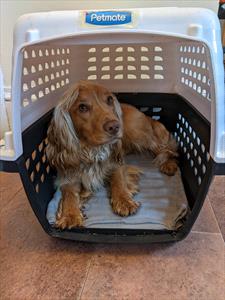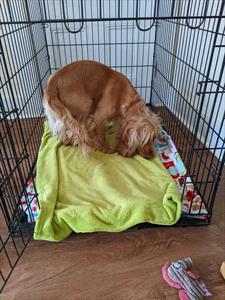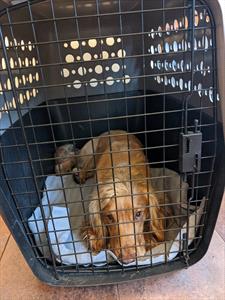The goal of confinement training is for the puppy to be comfortable in their crate or other safe haven, such as an exercise pen or behind a gate. This area should not be used as a punishment but as a relaxing place to go for nap time or to gnaw on a chew toy.
When you bring your puppy home, be sure to have the crate accessible from the family’s common space. For some people, it will be convenient to have multiple crates, such as in the living room, bedroom, and office.
Crate training can go wrong when people confine the puppy and then leave. Puppies should not be left to “cry it out” and crates should never be kicked or shaken to quiet a puppy. Begin by either removing the door or tying it back so it doesn’t startle your puppy.
Toss several treats in the back of the crate and allow the puppy to find them. Do this multiple times a day and when the puppy goes inside to check for treats, you can reward them again.
Next, add the door. As your puppy goes into the crate, gently close the door, and give your puppy a treat through the door. Open the door and allow them to come out. Only close the door for a few seconds at first, then slowly increase how long the puppy is confined.
To practice, have the crate nearby while you watch a movie, read a book or work at your computer. Your puppy should have a safe chew, or you can drop treats in the crate in the same spot each time so that the puppy can relax rather than hunt for them. If your puppy is relaxed with you nearby, try doing some activities with a little more movement, such as folding laundry or making dinner. Your puppy should still be able to see you and you should continue to give treats.
If your puppy remains comfortable, try briefly leaving the room, then return and give a treat. If your dog gets upset, leave for a shorter time and return before they become stressed, giving a treat before they vocalize. If they still seem upset, let them out. Don’t let the puppy continue to cry.
Before practicing crate confinement, be sure your puppy has been taken outside to the bathroom and is ready for a nap. Too much time in a crate can make the dog anxious.
Confinement can be scary and frustrating for your new puppy so go slowly with training. A negative experience in the crate can make training harder. Keep sessions short and positive. If you are concerned that your puppy is showing signs of separation anxiety, seek professional help.





